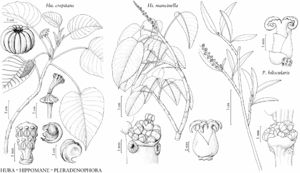Difference between revisions of "Hura crepitans"
Sp. Pl. 2: 1008. 1753.
FNA>Volume Importer |
imported>Volume Importer |
||
| (6 intermediate revisions by 2 users not shown) | |||
| Line 12: | Line 12: | ||
}}{{Treatment/ID/Special_status | }}{{Treatment/ID/Special_status | ||
|code=F | |code=F | ||
| − | |label= | + | |label=Illustrated |
}} | }} | ||
|basionyms= | |basionyms= | ||
| Line 30: | Line 30: | ||
|elevation=0–10 m. | |elevation=0–10 m. | ||
|distribution=Fla.;West Indies;Central America;South America;widely cultivated and often escaped throughout tropical regions of the world. | |distribution=Fla.;West Indies;Central America;South America;widely cultivated and often escaped throughout tropical regions of the world. | ||
| − | |discussion=<p>In the flora area, Hura crepitans is found only in Miami-Dade and Monroe (Keys only) counties. The capsules dehisce explosively, producing a loud sound and throwing the seeds up to 45 m (M. D. Swain and T. Beer 1977).</p> | + | |introduced=true |
| + | |discussion=<p>In the flora area, <i>Hura crepitans</i> is found only in Miami-Dade and Monroe (Keys only) counties. The capsules dehisce explosively, producing a loud sound and throwing the seeds up to 45 m (M. D. Swain and T. Beer 1977).</p> | ||
|tables= | |tables= | ||
|references= | |references= | ||
| Line 39: | Line 40: | ||
-->{{#Taxon: | -->{{#Taxon: | ||
name=Hura crepitans | name=Hura crepitans | ||
| − | |||
|authority=Linnaeus | |authority=Linnaeus | ||
|rank=species | |rank=species | ||
| Line 54: | Line 54: | ||
|publication title=Sp. Pl. | |publication title=Sp. Pl. | ||
|publication year=1753 | |publication year=1753 | ||
| − | |special status=Introduced; | + | |special status=Introduced;Illustrated |
| − | |source xml=https:// | + | |source xml=https://bitbucket.org/aafc-mbb/fna-data-curation/src/2e0870ddd59836b60bcf96646a41e87ea5a5943a/coarse_grained_fna_xml/V12/V12_1067.xml |
|genus=Hura | |genus=Hura | ||
|species=Hura crepitans | |species=Hura crepitans | ||
Latest revision as of 19:13, 5 November 2020
Trees, to 30 m; latex copious, caustic. Leaves: stipules leaving scar around stem, 6–10 × 2–4 mm; petiole 10–20 cm, glands 2 adaxially at apex; blade broadly ovate to orbiculate, 10–25 × 8–15 cm, base cordate, margins crenate-serrulate with 10–20 teeth on each side, apex acuminate; midvein and secondary veins prominent. Staminate inflorescences: peduncle (2–)5–10(–15) cm, fertile portion 2–5 cm, 60–80-flowered; staminate bracts membranaceous, enclosing flowers prior to anthesis. Pedicels: pistillate 1–5 cm. Staminate flowers: calyx cup-shaped, 1 mm, 3–5-lobed; staminal column to 2.5 mm, anthers usually in 2, rarely in 3, whorls. Pistillate flowers red; calyx cup-shaped, 3–5(–8) mm, 5-lobed; style 30–50 mm, terminating in thick apical disc 1 cm diam. with 5–20 radiating lobes 5–10 mm. Capsules depressed-globose, 3–5 × 6–10 cm. Seeds brownish, 15–20 mm diam., 5–8 mm thick, smooth.
Phenology: Flowering Jan–May; fruiting (Mar–)May–Sep.
Habitat: Hammocks and disturbed ground.
Elevation: 0–10 m.
Distribution
Introduced; Fla., West Indies, Central America, South America, widely cultivated and often escaped throughout tropical regions of the world.
Discussion
In the flora area, Hura crepitans is found only in Miami-Dade and Monroe (Keys only) counties. The capsules dehisce explosively, producing a loud sound and throwing the seeds up to 45 m (M. D. Swain and T. Beer 1977).
Selected References
None.
